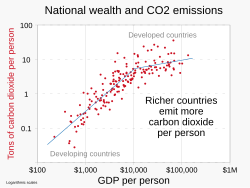Types of economic models
Many economic tools are employed to understand the economic aspects around impacts of climate change, climate change mitigation and adaptation. Several approaches exist. Econometric models (statistical models) are used to estimate the impacts of weather and climate on economic variables, either globally or for a specific sector. Structural economic models look at market and non-market impacts affecting the whole economy through its inputs and outputs. Process models simulate physical, chemical and biological processes under climate change, and the economic effects. [11] : 2495
Process-based models

Intergovernmental Panel on Climate Change (IPCC) has relied on process-based integrated assessment models (PB-IAM [21] ) to quantify mitigation scenarios. [22] [23] They have been used to explore different pathways for staying within climate policy targets such as the 1.5 °C target agreed upon in the Paris Agreement. [24] Moreover, these models have underpinned research including energy policy assessment [25] and simulate the Shared socioeconomic pathways. [26] [27] Notable modelling frameworks include IMAGE, [28] MESSAGEix, [29] AIM/GCE, [30] GCAM, [31] REMIND-MAgPIE, [32] [33] and WITCH-GLOBIOM. [34] [35] While these scenarios are highly policy-relevant, interpretation of the scenarios should be done with care. [36]
Non-equilibrium models include [37] those based on econometric equations and evolutionary economics (such as E3ME), [38] and agent-based models (such as the agent-based DSK-model). [39] These models typically do not assume rational and representative agents, nor market equilibrium in the long term. [37]Structural models
Computable general equilibrium models
Computable general equilibrium (CGE) models are a class of economic models that use actual economic data to estimate how an economy might react to changes in policy, technology or other external factors. CGE models are also referred to as AGE (applied general equilibrium) models. A CGE model consists of equations describing model variables and a database (usually very detailed) consistent with these model equations. The equations tend to be neoclassical in spirit, often assuming cost-minimizing behaviour by producers, average-cost pricing, and household demands based on optimizing behaviour.
CGE models are useful whenever we wish to estimate the effect of changes in one part of the economy upon the rest. They have been used widely to analyse trade policy. More recently, CGE has been a popular way to estimate the economic effects of measures to reduce greenhouse gas emissions.Aggregate cost-benefit models
Integrated assessment models (IAMs) are also used to make aggregate estimates of the costs of climate change. These (cost-benefit) models balance the economic implications of mitigation and climate damages to identify the pathway of emissions reductions that will maximize total economic welfare. [40] In other words, the trade-offs between climate change impacts, adaptation, and mitigation are made explicit. The costs of each policy and the outcomes modelled are converted into monetary estimates.
The models incorporate aspects of the natural, social, and economic sciences in a highly aggregated way. Compared to other climate-economy models (including process-based IAMs), they do not have the structural detail necessary to model interactions with energy systems, land-use etc. and their economic implications. [40]
Statistical (econometric) methods
A third modelling approach uses empirical, statistical methods to investigate how the economy is affected by weather variation. [11] : 2495 [41] : 755 This approach can identify effects of temperature, rainfall, drought and storms on agriculture, energy demand, industry and other economic activity. Panel data of weather variation over time and space, e.g. from ground station observations or (interpolated) gridded data is aggregated for economic analysis to investigate effects on national economies. [41] These studies show that for example, hot years are linked to lower income growth in poor countries, and low rainfall is linked to reduced incomes in Africa. [41] : 755 Other econometric studies show that there are negative impacts of hotter temperatures on agricultural output, on labour productivity and in outdoor industries such as mining and forestry. The analyses are used to estimate the costs of climate change in the future. [41]












